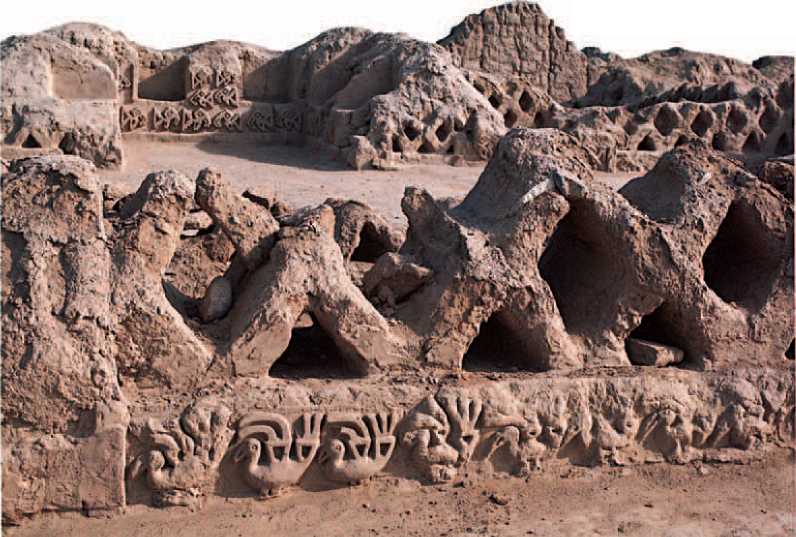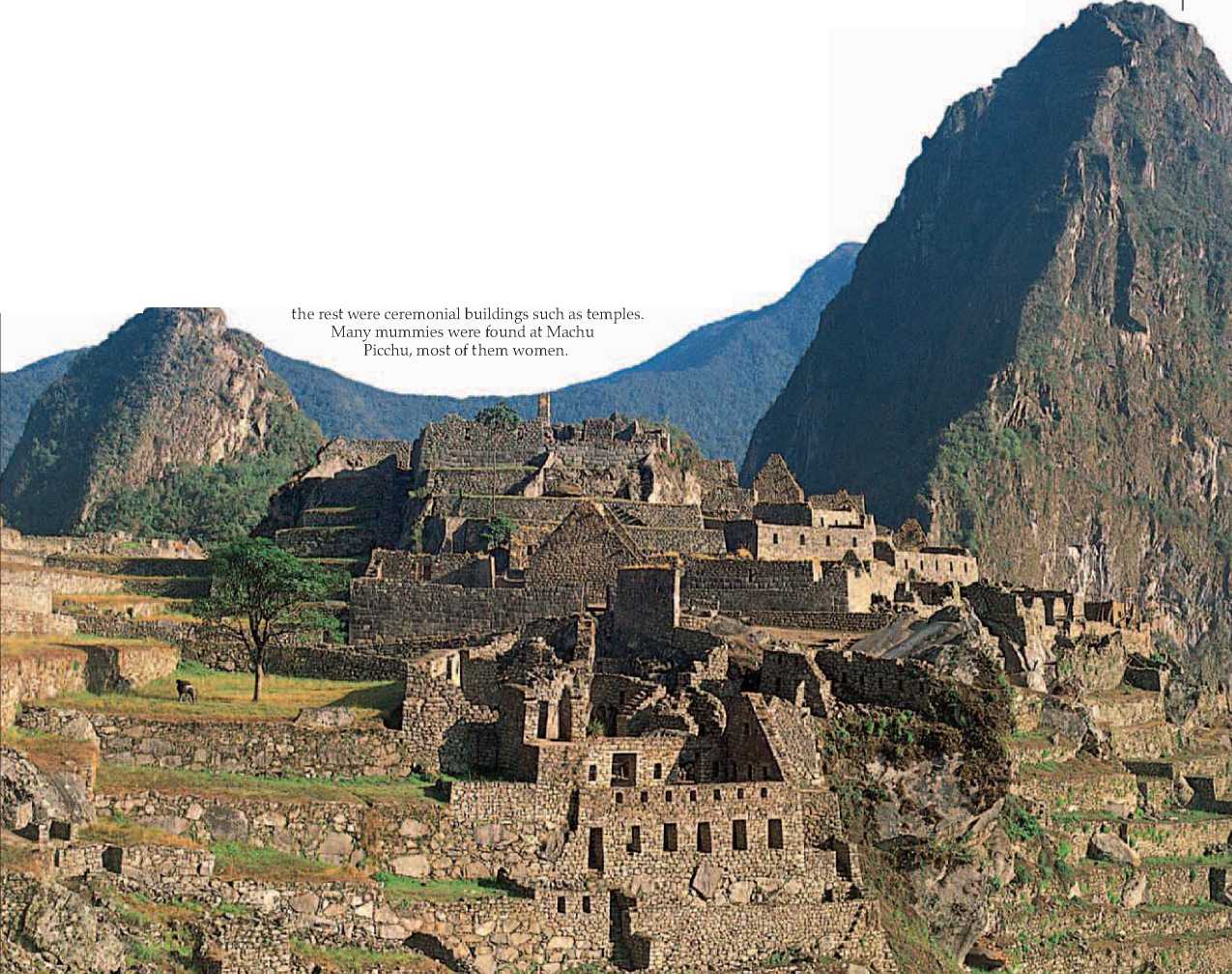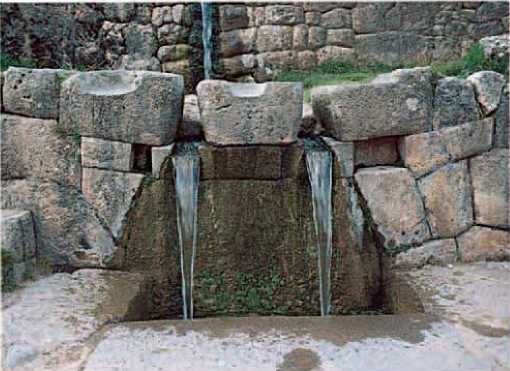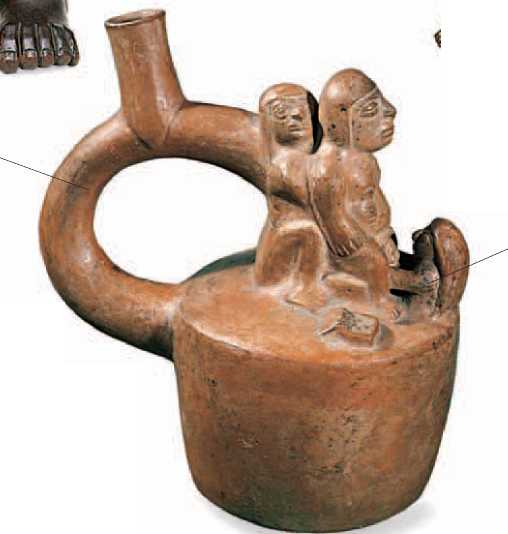THE PEOPLE OF THE ANDEAN REGION lived either in highland or coastal areas. They huilt their cities to suit the location, using materials that were locally availahle. Typical highland buildings had sloping, thatched roofs and masonry walls. Buildings on the coast tended to have flat roofs and mud-hrick (adohe) walls covered hy painted mud plaster. Highland cities, such as Machu Picchu, could not he huilt on a regular grid plan like Chan Chan and other cities in flat, coastal areas. The first buildings to be lived in as homes date back to the 4th century bce. Government buildings, storehouses, bridges, canals, and other public constructions were built by ordinary people as a kind of labor tax, with the state providing the necessary materials.
INCA MASONS The Incas are renowned for their fine stonework. Masons cut huge, stone bricks using just a stone hammer and then polished them with wet sand. The bricks fit together so closely that no mortar was needed.
OLLANTAYTAMBO
The Inca town of Ollantaytambo has some of Peru's most impressive architectural remains.
This doorway is made of rectangular stone blocks, each precisely cut and fit to a specific position.
TIAHUANACO ......
The city of Tiahuanaco (p. 10) is situated on a high plain nearly 13,000 ft (4,000 m) above sea level and rimmed by the Andes Mountains.
The stunning architecture of its ceremonial center included an impressive number of stone sculptures.
The Gateway of the Sun (above) was carved from a single block of stone. A carving over the doorway portrays a Sun god.

Bird motif on adobe wall of oyal compound, Ghan Ghan

ADOBE DECORATION
The Ghimu decorated their thick adobe (mud) walls with molded motifs, usually associated with the sea, such as birds, fish, and men in boats.
CHAN CHAN
The Ghimu people built real urban centers, and Ghan Ghan, the coastal capital of the Ghimu Empire, is a good example of this. The city was organized on a grid plan and covered approximately 2.3 sq miles (6 sq km). It contained 10 compounds, each enclosed by a high adobe wall. These are thought to be the royal residences and administrative centers of the Ghimu kings. Each king lived, died, and was buried in his own secluded compound.
Royal compound at Ghan Ghan, capital of the Ghimu kingdom


Machu Picchu

European map of Cuzco
CUZCO
Encircled by high peaks, Cuzco—the religious and political capital of the Incas—is situated at the heart of the Andes. The town was divided into sections by narrow paved streets, designed to represent the four quarters of the Incan Empire. It had ceremonial plazas, palaces, and temples. Only the rulers and nobility lived in the city center. This European drawing wrongly portrays Cuzco as a walled town. Much of the city was destroyed by the Spanish, who built their own city on the Inca ruins.

Inca baths at Tambomachay
SACSAHUAMAN FORT
Cuzco was protected from the enemy by the fortress of Sacsahuaman, built on a steep hill overlooking the city from the north. The fort was constructed with locally quarried stone, and each giant block was individually shaped. These three impressive stone walls, which stand 52 ft (16 m) high, guarded the fortress.
MACHU PICCHU
Strategically positioned at the edge of the Incan Empire, the remote city of Machu Picchu was probably built in the mid to late 15th century. The Spanish conquistadores never found Machu Picchu, and the city was not discovered until 1911. The site is an outstanding example of Incan architecture—a natural fortress protected by steep slopes, surrounded by high mountain peaks and approached horn only one direction. Of its 143 granite buildings, about 80 were houses and
Stone walls of Sacsahuaman fort

INCA BATHS
Inca palaces sometimes had sunken stone baths in which the kings could relax and bathe. Water ran along stone channels into the baths. These baths at Tambomachay, near Cuzco, were built at the site of a sacred spring. They were used by the Inca kings.


Figure has eyes and teeth inlaid with shell


Stirrup handle

Two helpers aid a woman g;iving birth


COUPLE EMBRACING
In both Mesoamerica and the Andean region, a wife's role was to obey her husband.
Even in art, women were often depicted in a passive stance, and men in a more active position. This Mayan pottery statue shows a man embracing a woman. Both wear elaborate headdresses, ear plugs, and necklaces indicating that the they were a wealthy couple.
Aztec couple during marriage ceremony
EERTIEE BEESSING
Both the Mesoamericans and the Incas considered it important for a married couple to have children. The Aztecs worshiped goddesses of fertility. This wooden Aztec sculpture is of a young woman dressed in a skirt and bare-breasted. She maybe a goddess of fertility.
CHIEDBIRTH SCENE The Aztecs did not have midwives. When giving birth, Andean women were helped by women who had given birth to twins, and also by their neighbors. After the birth, the mother washed herself and her baby in the river. The umbilical cord was not thrown away, but was kept in the house.




 World History
World History









